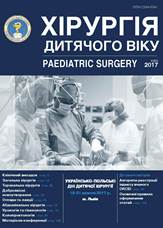Bone system status in children with gastroduodenal pathology
DOI:
https://doi.org/10.15574/PS.2017.57.103Keywords:
osteopenia, ultrasonic densitometry, chronic gastroduodenitis, childrenAbstract
Due to the significant «rejuvenation» of osteoporosis, the interest in the status of bone density (BMD) in children with different somatic pathologies is increasing. In particular, the bone system status in children with the pathology of gastroduodenal zone plays an important role in such a case.Objective – to study the factors that contribute to the formation of osteopenic syndrome in children with the gastroduodenal pathology.
Material and methods. 54 children with chronic gastroduodenitis were examined – 30 boys and 24 girls aged from 6 to 15 years. The patients were provided with a complex clinical, laboratory and instrumental examinations, provided by Unified clinical protocols of medical care for children with diseases of the digestive system. The patients and their parents were interviewed on the peculiarities of the course of main illness, nutrition and lifestyle according to our specially designed questionnaire. In addition, in all patients the blood level of calcium, urinolysis, and ultrasonic densitometry were determed.
Results. Chronic gastroduodenitis has a negative effect on the bone system status in children. Thus, the average BMD in chronic gastroduodenitis was 79% compared with 98% in healthy children. In 52 patients out of 54, biliary tract diseases have been identified as concomitant pathology. At the same time, the lower BMD was observed in children with more severe course of main disease; with the history of an excessive drug intake affecting the acid-forming gastric function; low content in diet of calcium-rich food, and excessive use of phosphate-rich food. Higher BMD levels were observed in children, who are regularly involved in sports and are in the open air for more than 2 hours a day. In this case, the Ca serum level does not reflect its deficit in the bone system. No dependence of osteopenic syndrome from Helicobacter pylory (+) or Helicobacter pylory (-) type of chronic gastroduodenitis was also found. For the correction of osteopenic syndrome, all patients with reduced BMD were administered calcium supplements and followed dietary and lifestyle recommendations. In 6-month re-examination, an increase of average BMD up to 11 % was found.
Conclusions. Due to the chronic gastrointestinal pathology in children, there is a decrease of BMD. The level of BMD depends on the course of disease, environmental factors, lifestyle and diet. Their optimization and the administration of calcium drugs lead to a possible increase of BMD.
Downloads
Issue
Section
License
The policy of the Journal “PAEDIATRIC SURGERY. UKRAINE” is compatible with the vast majority of funders' of open access and self-archiving policies. The journal provides immediate open access route being convinced that everyone – not only scientists - can benefit from research results, and publishes articles exclusively under open access distribution, with a Creative Commons Attribution-Noncommercial 4.0 international license(СС BY-NC).
Authors transfer the copyright to the Journal “PAEDIATRIC SURGERY.UKRAINE” when the manuscript is accepted for publication. Authors declare that this manuscript has not been published nor is under simultaneous consideration for publication elsewhere. After publication, the articles become freely available on-line to the public.
Readers have the right to use, distribute, and reproduce articles in any medium, provided the articles and the journal are properly cited.
The use of published materials for commercial purposes is strongly prohibited.

